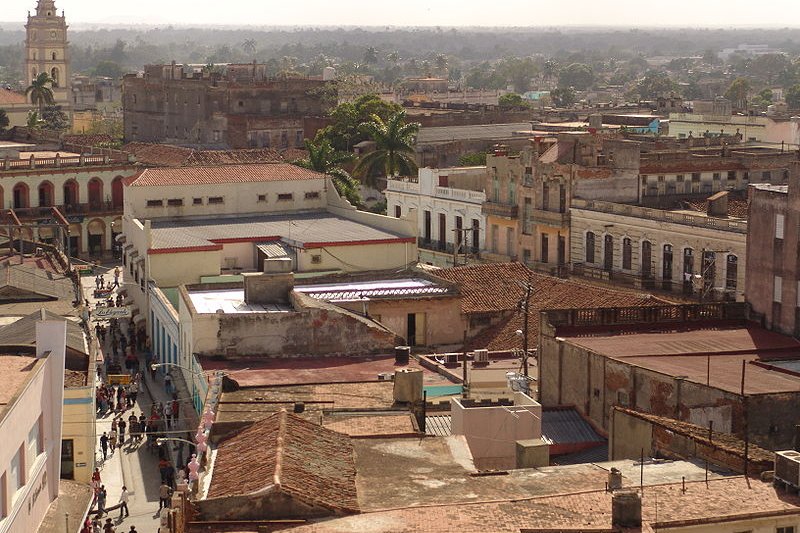
 Camagüey, Cuba
Camagüey, CubaSource: https://commons.wikimedia.org/wiki/File:Camaguey_rooftops_2.jpg
Author: Danleo

Camagüey the third largest city in Cuba, is located in the vast pastureland in the central part of the country. It covers 1,106 sq km (427 sq mi) and has a population of 325,000.
Camagüey was founded in 1515m and was originally called Santa María del Puerto del Príncipe. The settlement was relocated inland in 1528, as an attempt to ward of frequent raids by pirates. For the same purpose, the streets of the town was built with many winding alleys, many ending in dead ends. This labyrinthine design, with only one outlet between Camagüey and the outside, ensures that any pirate foolish enough to enter would be easily trapped and killed. In 2008, the historic center of Camagüey was declared a World Heritage Site.
The symbol of Camagüey is the clay pot, called tinajón. This can be found in abundance all over the town. The range in size from a few centimeters to two meters. The clay for these pots come from the nearby Sierra de Cubitas. Their usage was introduced in the early 18th century by immigrants from Catalonia. Traditionally used for collecting rainwater and storage of food, today they have becoming a tourist souvenir.
 Statue of Ignacio Agramonte in the Plaza de Revolucìon in Camagüey
Statue of Ignacio Agramonte in the Plaza de Revolucìon in CamagüeySource: https://commons.wikimedia.org/wiki/File:Ignacio_agramonte_statue.jpg
Author: Danleo

Camagüey is the birthplace of Ignacio Agramonte, the Cuban revolutionary leader who was celebrated with many place names within the city.
Visiting Camagüey
There are flights between Havana and Camagüey, arriving at the Ignacio Agramonte Airport, which is about 5 miles from downtown. Alternatively, you can take a bus from Havana as well as from Sancti Spiritus, Santa Clara, Santiago de Cuba, Trinidad or Varadero.Sights & Attractions in the Historic Center of Camagüey
- Casa Natal de Ignacio Agramonte
18th century house where the Cuban revolutionary leader was born in 1841. - Catedral de Nuestra Señora de la Candelaria
The cathedral of Camagüey is dedicated to its patron saint, Our Lady of Candelaria. It was first built in 1735 and has been rebuilt a few times. - Iglesia de la Merced
Church dating back to 1601 but was rebuilt in the 18th century to spot its present Baroque façade. - Parque Ignacio Agramonte
Park named after the 19th century Cuban revolutionary leader who was born in Camagüey and went on to craft the country's first constitution. - Teatro Principal
Local theater first opened in 1850 is home to the Camagüey Ballet, one of the leading performing arts companies in Latin America.
Sights & Attractions in Camagüey outside the Historic Center
- Cinco Esquinas
A complex junction of several streets in Camagüey. - Iglesia de Nuestra Señora de la Soledad
Church where Ignacio Agramonte was baptized and got married. - Iglesia de San Juan de Dios
A small yet fascinating church in Camagüey still having its original wooden floors, ceiling and choir. - Iglesia del Carmen
Baroque church from 1825 located at Plazuela de la Bedoya. - King Rancho
Formerly a cattle ranch, this has today opened to accept tourists with a restaurants and rooms for overnight guests. - Museo Provincial Ignacio Agramonte
Formerly the headquarters to the Spanish cavalry in the 19th century, this building today houses a museum on the history, natural history and art of the city. - Parque Casino Campestre
Once the site of agricultural fairs, this site becomes the biggest public park in Cuba in the 19th century. - Plaza San Juan de Dios
Commonly known as Plaza del Padre Olallo after a popular priest who looked after the sick in the city hospital, this is a charming, quiet square in Camagüey.
 Latest updates on Penang Travel Tips
Latest updates on Penang Travel Tips
About this website

Dear visitor, thank you so much for reading this page. My name is Timothy Tye and my hobby is to find out about places, write about them and share the information with you on this website. I have been writing this site since 5 January 2003. Originally (from 2003 until 2009, the site was called AsiaExplorers. I changed the name to Penang Travel Tips in 2009, even though I describe more than just Penang but everywhere I go (I often need to tell people that "Penang Travel Tips" is not just information about Penang, but information written in Penang), especially places in Malaysia and Singapore, and in all the years since 2003, I have described over 20,000 places.
While I try my best to provide you information as accurate as I can get it to be, I do apologize for any errors and for outdated information which I am unaware. Nevertheless, I hope that what I have described here will be useful to you.
To get to know me better, do follow me on Facebook!
Copyright © 2003-2025 Timothy Tye. All Rights Reserved.

 Go Back
Go Back